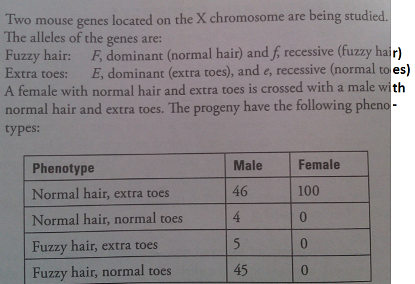Hey, I remember this. Lemme edit it as I actually got it right.
So the female is X(Ff) and X(Ee), because the male shows a mixture of recessive and dominant. The male is X(FE) because those are the only X he can display. Y is obviously ignored here.
So males can be: X(FE) X(Fe) X(fE) X(fe), all of which is shown. There are three recombs, the ones that aren't X(FE).
Females can only display the dominant phenotype because the male contributes X(FE), any X(fe) would get washed out.
=== Let's analyze what I did because I just memorized the answer in TPR ===
You're told both animals are dominant expressions. You look at the chart and see out of eveyrthing, the female still has dominant. Therefore if there were recessive options--which there are--they are ignored. It is either being masked, or pure dominant.
But...the males show recessive traits. They can only inherit an X from their mother. So the mother in this case, she ain't homozygous X! So she's probably X(Ff, Ee). This explains the rest of what I wrote here.
A) I have no idea what this means.
B) I have no idea what this means as well. Do they mean FE or fe ? In that case, then no, because X(fe) is an option.
C) I have no idea what this means.
D) This is the most applicable out of what I said?
Genetics is a really weak chapter for me. Thanks for reminding me I should go over it bro.




